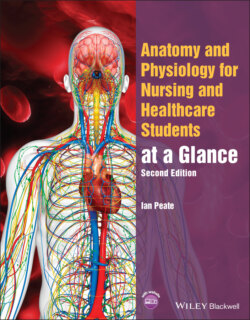Читать книгу Anatomy and Physiology for Nursing and Healthcare Students at a Glance - Ian Peate - Страница 19
Оглавление7 Blood
Figure 7.1 Centrifuged blood.
Source: Tortora GJ, Derrickson B. Tortora’s Principles of Anatomy and Physiology, 15th edn. Hoboken: Wiley, with permission from John Wiley & Sons (2017).
Figure 7.2 Three principal formed components: red blood cells, white blood cells and platelets.
Source: Tortora GJ, Derrickson B. Tortora’s Principles of Anatomy and Physiology, 15th edn. Hoboken: Wiley, with permission from John Wiley & Sons (2017).
Figure 7.3 Compoments of blood.
Figure 7.4 Haemopoiesis.
Source: Tortora GJ, Derrickson B. Tortora’s Principles of Anatomy and Physiology, 15th edn. Hoboken: Wiley (2017).
Blood is a liquid connective tissue made up of cells surrounded by a liquid extracellular matrix.
Functions
Transportation
Blood transports oxygen from the lungs to the cells and carbon dioxide from the cells to the lungs to be exhaled. It carries nutrients from the gastrointestinal tract to cells and hormones from endocrine glands to other body cells. Blood is also responsible for the transportation of heat and waste products to several organs for elimination from the body.
Regulation
As the blood circulates, it helps to maintain blood fluid homeostasis by regulating pH through the use of chemicals that convert strong acids or bases into weak ones (known as buffers). It also helps adjust body temperature through the heat‐absorbing and coolant properties of the water contained in blood plasma and its fluctuating flow through the skin, via which excess heat can be lost from the blood to the environment. Furthermore, blood osmotic pressure changes the water content of cells.
Protection
As blood clots, it becomes gel‐like; after injury, this protects against excessive blood loss from the cardiovascular system. The white blood cells protect against disease as they undertake phagocytosis. Several types of blood proteins, including antibodies, interferons and complement, help to protect against disease in a number of ways.
Blood components
Blood has two components with around 45% formed elements and 55% blood plasma (Figure 7.1). Usually, more than 99% of the formed elements of blood are red blood cells (RBCs). White blood cells (WBCs) and platelets account for less than 1% of the formed elements.
Formed elements of blood
There are three principal formed elements components: red blood cells, white blood cells and platelets (Figure 7.2). Red blood cells or erythrocytes transport oxygen from lungs to body cells, and carbon dioxide from body cells to the lungs. White blood cells or leucocytes offer protection from invading disease‐causing organisms and other foreign bodies. There are a number of types of WBCs: neutrophils, basophils, eosinophils, monocytes and lymphocytes. Lymphocytes are further subdivided into B lymphocytes (B cells), T lymphocytes (T cells) and natural killer (NK) cells. Each WBC contributes specifically to the body’s defence mechanism. The last formed elements are platelets; these are fragments of cells and have no nucleus. Among other activities, they release chemicals, promoting blood clotting when blood vessels are damaged.
Blood plasma
Plasma is a straw‐coloured liquid. Figure 7.3 depicts the composition of blood plasma along with the numbers of the different types of formed elements in blood.
Plasma is about 91.5% water and 8.5% solutes, most of which are proteins. Some of the proteins in blood plasma are found elsewhere in the body; those confined to blood are known as plasma proteins. Certain blood cells develop into cells that produce gamma globulins, an important type of globulin; these are called antibodies or immunoglobulins as they are produced during specific immune responses. Other solutes in plasma include electrolytes, nutrients, regulatory substances, for example enzymes and hormones, gases as well as waste products such as urea, uric acid, creatinine, ammonia and bilirubin.
Development of blood cells
Haemopoiesis describes the process by which the formed elements of blood develop (Figure 7.4). Red bone marrow is the primary centre for haemopoiesis.
Red blood cells are biconcave discs containing oxygen‐carrying protein called haemoglobin. The biconcave shape is maintained by a network of proteins called spectrin. This network allows the red blood cells to change shape as they are transported through the blood vessel. Young red blood cells contain a nucleus; this is absent in mature red blood cells, thus increasing the oxygen‐carrying capacity of the cell.
Haemoglobin is composed of the protein globin bound to the iron‐containing pigment called haem. Each haemoglobin molecule has four atoms of iron, and each atom of iron will transport one molecule of oxygen. There are around 250 million haemoglobin molecules in one RBC and one RBC will transport 1 billion molecules of oxygen
White blood cells circulate for only a short period of their life span; most of their life span is spent migrating through dense and loose connective tissues. All WBCs migrate from the blood vessel by a process known as emigration. Some WBCs are capable of phagocytosis.
Platelets are small blood cells consisting of cytoplasm surrounded by a plasma membrane produced in the bone marrow from megakaryocytes; fragments of megakaryocytes break off to form platelets. They are around 2–4 μm in diameter, they have no nucleus and their life span is approximately 5–9 days. Platelets have a vital role to play in blood loss as they form platelet plugs, sealing the holes in the blood vessels and releasing chemicals that aid blood clotting.
Clinical practice point
A bone marrow sample is obtained in order to diagnose certain blood disorders, such as leukaemia and severe anaemias. This usually involves bone marrow aspiration or a bone marrow biopsy. Both types of samples are usually taken from the iliac crest, although samples can be aspirated from the sternum. The tissue or cell sample is sent for analysis.
